项目代码
- /* Arduino Nano DS3231 clock with LED Matrix 4x(8x8) SPI
- * Version 2 - updated 15/05/2-21
- * Arduino Nano 5V logic - 32kB prog. space
- * Tools:Board: Arduino Nano; Processor: ATmega328P (Old Bootloader)!!
- * LED Matrix 4x(8x8) SPI with connector on the right side (last module)
- * https://www.banggood.com/MAX7219-Dot-Matrix-Module-4-in-1-Display-For-Arduino-p-1072083.html?rmmds=myorder&cur_warehouse=CN
- *
- * CONNECTIONS:
- * >> LCD 4x64 -> Arduino Nano: (using Hardware SPI):
- * 5V -> 5V pin
- * GND -> GND pin
- * CLK_PIN -> 13 // or SCK
- * DATA_PIN -> 11 // or MOSI
- * CS_PIN -> 10 // or SS
- *
- * >> DS3231 RTC -> Arduino Nano:
- * SDA (DAT) -> A4
- * SCL (CLK) -> A5
- * Inspired by : 1) Arduino Clock by AnthoTRONICS Last edit: March 22,2019
- * but without MD_parola because of its large footprint! New getdate function.
- * 2) Simplest UNO Digital Clock Ever by plouc68000:
- * https://create.arduino.cc/projecthub/plouc68000/simplest-uno-digital-clock-ever-4613aa?ref=user&ref_id=680368&offset=1
- * 3) LEDDotMatrixClock.ino by Leonardo Sposina, but here without "Max72xxPanel.h"
- * https://github.com/leonardosposina/arduino-led-dot-matrix-clock/blob/master/LEDDotMatrixClock/LEDDotMatrixClock.ino
- * Not using Max72xxPanel.h, but small size digits are stll used. Small footprint code here.
- *
- * project: 113558 bytes (44%); variables 372 bytes (17%)
- * Author: MVP https://www.hackster.io/M-V-P
- */
-
- #include <SPI.h>
- #include "DS3231.h"
- #include "MD_MAX72xx_lib.h"
- //#include "Font_Data.h"
-
- DS3231 rtc(SDA, SCL); // Real time clock
-
- const byte LDR_PIN = A2; // LDR Sensor pin
-
- #define MAX_DEVICES 4
- // Define pins
- #define CLK_PIN 13 // or SCK
- #define DATA_PIN 11 // or MOSI
- #define CS_PIN 10 // or SS
- // Define below your LED matrix hardware model:
- //#define HARDWARE_TYPE MD_MAX72XX::ICSTATION_HW
- #define HARDWARE_TYPE MD_MAX72XX::FC16_HW
-
- #define USE_NEW_FONT 1
-
- #define BUF_SIZE 20 // text buffer size
- #define CHAR_SPACING 1 // pixels between characters
-
- char buf[BUF_SIZE], secs[4];
- uint8_t hh, mm, ss, dots;
-
- // Definition of the small fonts:
- uint8_t Font3x5 [ 10 ][ 3 ]={
- { 248, 136, 248}, // 48 0
- {144, 248, 128}, // 49 1
- {200, 168, 184}, // 50 2
- {136, 168, 248}, // 51 3
- {112, 72, 224}, // 52 4
- {184, 168, 232}, // 53 5
- {248, 168, 232}, // 54 6
- {8, 232, 24}, // 55 7
- {248, 168, 248}, // 56 8
- {184, 168, 248}}; // 57 9
-
- char months[12][4]= {"Jan","Feb","Mar","Apr","May","Jun","Jul","Aug","Sep","Oct","Nov","Dec"};
- char* wday;
- // SPI hardware interface
- // Max72xxPanel matrix = Max72xxPanel(CS_PIN, H_DISPLAYS, V_DISPLAYS);
- MD_MAX72XX matrix = MD_MAX72XX(HARDWARE_TYPE, CS_PIN, MAX_DEVICES);
-
- const byte WAIT = 100;
- const byte SPACER = 1;
- byte FONT_WIDTH;
-
- bool timeset=false;
-
- void adjustClock(String data) {
- byte _day = data.substring(0,2).toInt();
- byte _month = data.substring(3,5).toInt();
- int _year = data.substring(6,10).toInt();
- byte _hour = data.substring(11,13).toInt();
- byte _min = data.substring(14,16).toInt();
- byte _sec = data.substring(17,19).toInt();
- rtc.setTime(_hour, _min, _sec);
- rtc.setDate(_day, _month, _year);
- Serial.println(F(">> Datetime successfully set!"));
- timeset=true;
- }
-
- byte ledintensitySelect(int light) {
- byte _value = 0;
- if (light >= 0 && light <= 127) {
- _value = 12;
- } else if (light >= 128 && light <= 319) {
- _value = 3;
- } else if (light >= 320 && light <= 512) {
- _value = 0;
- }
- return _value;
- };
-
- void printText(uint8_t modStart, uint8_t modEnd, char *pMsg)
- // Print the text string to the LED matrix modules specified.
- // Message area is padded with blank columns after printing.
- {
- uint8_t state = 0;
- uint8_t curLen;
- uint16_t showLen;
- uint8_t cBuf[FONT_WIDTH];
- int16_t col = ((modEnd + 1) * COL_SIZE) - 1;
-
- matrix.control(modStart, modEnd, MD_MAX72XX::UPDATE, MD_MAX72XX::OFF);
-
- do // finite state machine to print the characters in the space available
- {
- switch(state)
- {
- case 0: // Load the next character from the font table
- // if we reached end of message, reset the message pointer
- if (*pMsg == '\0')
- {
- showLen = col - (modEnd * COL_SIZE); // padding characters
- state = 2;
- break;
- }
-
- // retrieve the next character form the font file
- showLen = matrix.getChar(*pMsg++, sizeof(cBuf)/sizeof(cBuf[0]), cBuf);
- curLen = 0;
- state++;
- // !! deliberately fall through to next state to start displaying
-
- case 1: // display the next part of the character
- matrix.setColumn(col--, cBuf[curLen++]);
-
- // done with font character, now display the space between chars
- if (curLen == showLen)
- {
- showLen = CHAR_SPACING;
- state = 2;
- }
- break;
-
- case 2: // initialize state for displaying empty columns
- curLen = 0;
- state++;
- // fall through
-
- case 3: // display inter-character spacing or end of message padding (blank columns)
- matrix.setColumn(col--, 0);
- curLen++;
- if (curLen == showLen)
- state = 0;
- break;
-
- default:
- col = -1; // this definitely ends the do loop
- }
- } while (col >= (modStart * COL_SIZE));
-
- matrix.control(modStart, modEnd, MD_MAX72XX::UPDATE, MD_MAX72XX::ON);
- }
-
- void setup() {
- pinMode(LDR_PIN, INPUT_PULLUP);
- Serial.begin(9600);
- Serial.println(F(">> Arduino 32x8 LED Dot Matrix Clock!"));
- Serial.println(F(">> Use <dd/mm/yyyy hh:mm:ss> format to set clock's date and hour!"));
- rtc.begin();
- matrix.begin();
- matrix.clear();
- FONT_WIDTH= 5 + SPACER; // The font width is 5 pixels
- matrix.control(MD_MAX72XX::INTENSITY, 2);; // Use a value between 0 and 15 for brightness
- rtc.setDOW(); // Required for a new RTC
- }
-
- void getDate()
- // Date Setup: Code for reading clock date
- {
-
- String dts = rtc.getDateStr(); // Get dd/mm/yyyy string
- String dds=dts.substring(0,2); // Extract date
- String mms=dts.substring(3,5); // Extract month
- int mm=mms.toInt(); // Convert to month number
- dds.concat(" ");
- dds.concat(String(months[mm-1])); // Rebuild date string as "dd Mmm"
- dds.toCharArray(buf,sizeof(buf)); // return buffer
- wday = rtc.getDOWStr(2);
- }
-
- void getHour()
- // Date Setup: Code for reading clock date
- { String dts = rtc.getTimeStr(); // Get hh:mm:ss string
- String hhs=dts.substring(0,2); // Extract hour
- String mms=dts.substring(3,5); // Extract minutes
- hh=hhs.toInt(); // Convert to number
- mm=mms.toInt(); // Convert to number mm
- ss=(dts.substring(6,8)).toInt(); // Extract seconds as number
-
- if (hh >= 0 && hh < 10) dots=7;
- if (hh > 9 && hh < 20) dots=11;
- if (hh > 19 && hh < 25) dots=13;
- if (hh%10 == 1) dots-=2;
-
- //String outmsg=dts.substring(0,5); // Extract hh:mm (optional)
- String outmsg=String(hh); // Extract h if h<10
- // outmsg.concat(":"); // add : but on 2 columns!!
- outmsg.concat(char(124)); // add 1 full column between numbers
- outmsg.concat(dts.substring(3,5)); // add mm
- outmsg.toCharArray(buf,BUF_SIZE);
- }
-
- // New version of function, using the small embedded fonts
- void showsec(uint8_t secs)
- { uint8_t secs1=secs%10;
- uint8_t secs2=secs/10;
- for (uint8_t k=0; k<3; k++){
- matrix.setColumn(MAX_DEVICES*8-26-k,Font3x5 [secs2][k]);
- matrix.setColumn(MAX_DEVICES*8-30-k,Font3x5 [secs1][k]);
- }
- }
-
- void loop() {
- byte ledIntensity = ledintensitySelect(analogRead(LDR_PIN));
- matrix.control(MD_MAX72XX::INTENSITY, ledIntensity);; // Use a value between 0 and 15 for brightness
-
- getHour(); // Read time from RTC
- printText(0,MAX_DEVICES-1,buf); // Show hh|mm from buf
- matrix.setColumn(MAX_DEVICES*8-dots,0); // Clear the |
- unsigned long inst =millis(); // mark this moment
-
- while (ss < 53){ // First 53 seconds of each minute show time
- while (millis() - inst > 1000){
- inst =millis();
- ss++; // Increase seconds
- showsec(ss); // Show seconds
- for (uint8_t i = 0; i < 2; i++){
- matrix.setColumn(MAX_DEVICES*8-dots,36); // Blinking two dots:
- delay(240);
- matrix.setColumn(MAX_DEVICES*8-dots,0);
- delay(240);
- }
- }
- }
-
- // Then "time" is scrolling upwards:
- for (uint8_t i=0; i<8; i++){
- matrix.transform(MD_MAX72XX::TSU);
- delay(3*WAIT);
- }
-
- // Write the current date:
- getDate();
- printText(0,MAX_DEVICES-1,buf);
- delay(20*WAIT);
-
- // Write the week day (if uncommented):
- //printText(0,MAX_DEVICES-1,wday);
- //delay(20*WAIT);
-
- // Write the estimated room temperature from the RTC sensor
- int temp = rtc.getTemp();
- temp=temp-1; // Offset -1 C
- String outmsg=String(temp);
- outmsg.concat(" C");
- outmsg.toCharArray(buf,BUF_SIZE);
- printText(0,MAX_DEVICES-1,buf);
- delay(20*WAIT);
-
- // Time setting in RTC if Serial monitor is activated in Arduino IDE:
- if (Serial.available() > 0 && timeset==false) {
- adjustClock(Serial.readString());
- }
- }
|

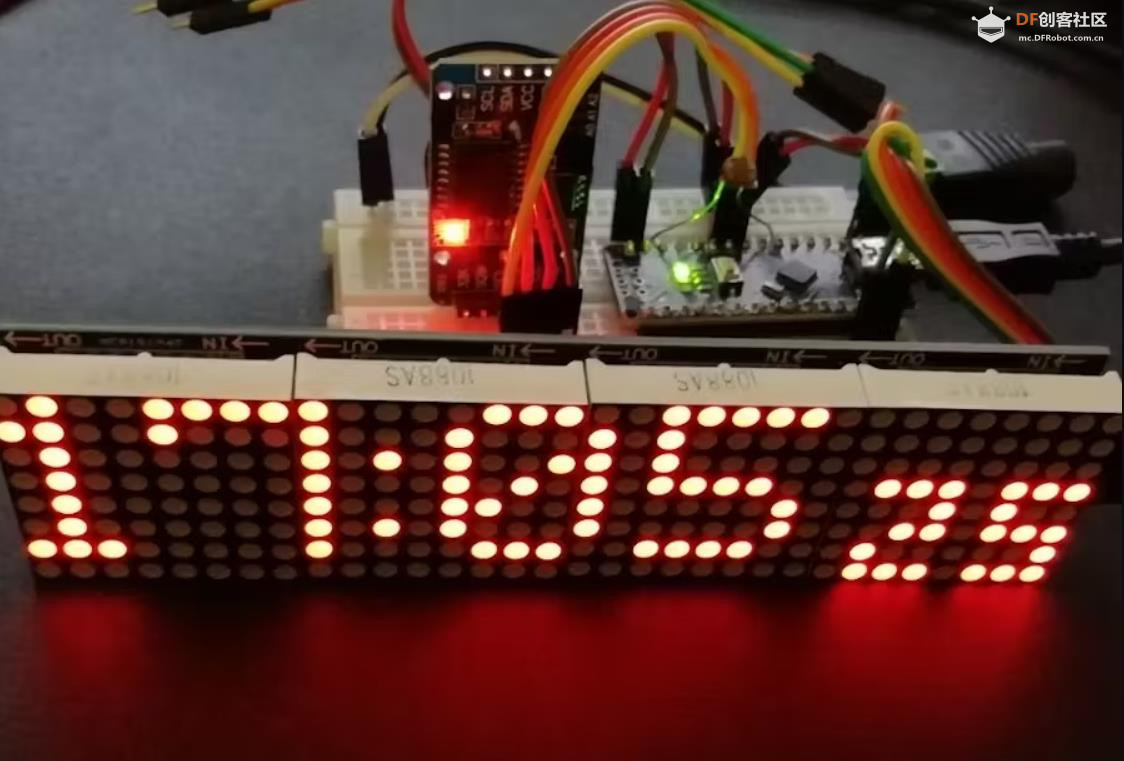
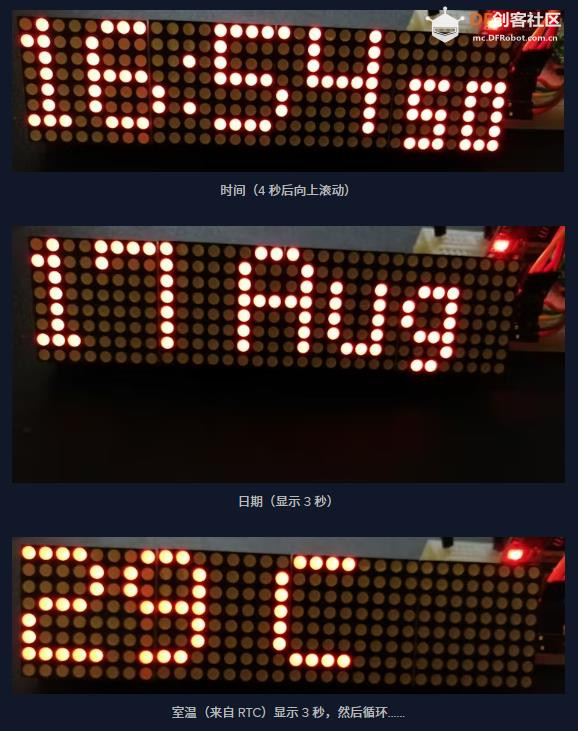
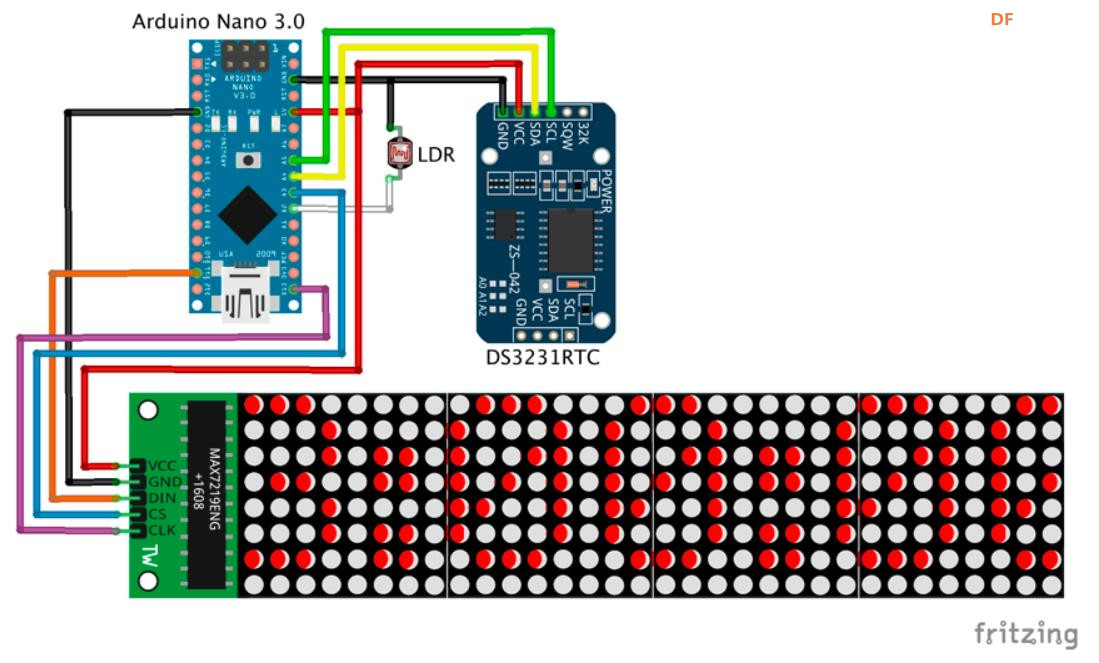
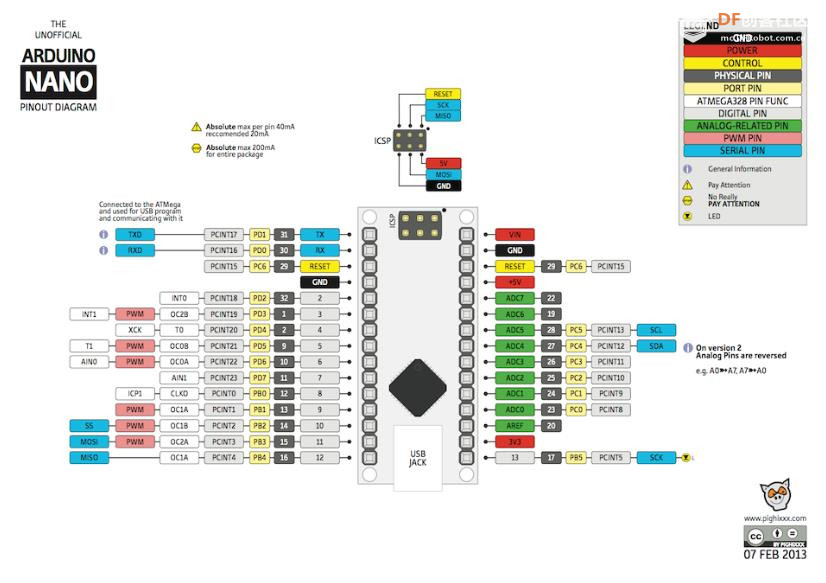
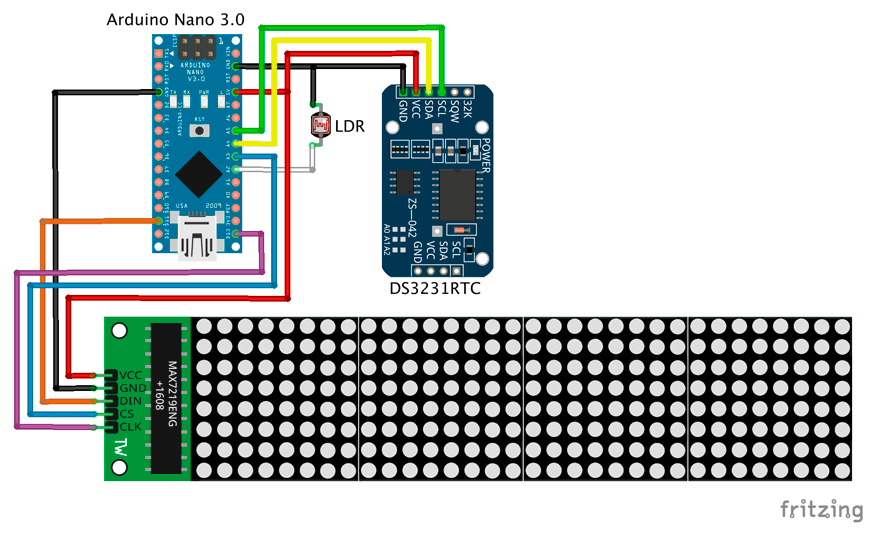
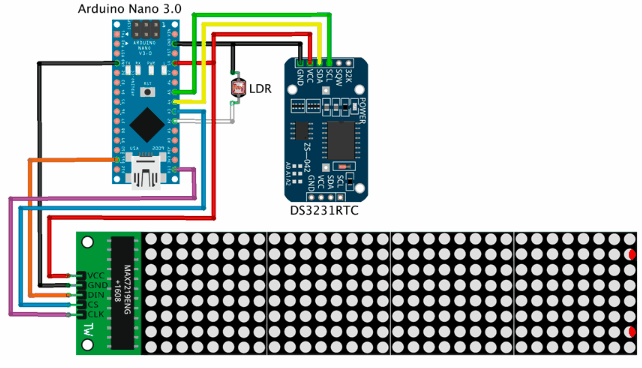
 沪公网安备31011502402448
沪公网安备31011502402448